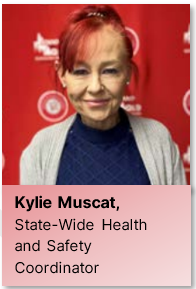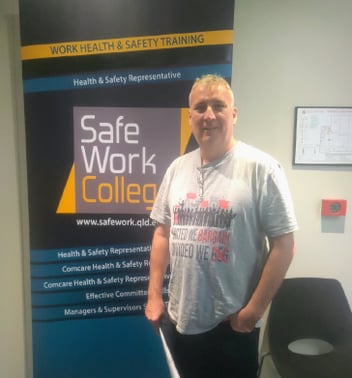HSR News April 2023 | Brave workers stand up for safety
 Over the past couple of months, we have been telling “your” stories. HSRs have shared their struggles, concerns, challenges, and wins – and I am hoping you continue to share, so we can keep hearing these awesome stories in future newsletters.
Over the past couple of months, we have been telling “your” stories. HSRs have shared their struggles, concerns, challenges, and wins – and I am hoping you continue to share, so we can keep hearing these awesome stories in future newsletters.
The important thing from sharing your stories is knowing you are not alone, and you will be successful addressing WHS issues in your workplaces.
Each of you will probably find yourselves in similar situations; sharing your experiences is important as it could help someone else.
This month I thought I would share a story with you that is close to my heart, a story of five hard working Queenslanders who stood up for their safety and won.
[For confidentiality reasons no names will be mentioned in this story]
 In 2019 I met a group of five female workers, who at that time were working in community roles providing a service to clients in their homes. This was a role that kept them relatively isolated from each other as the duties they performed were, for the most part, carried out on their own.
In 2019 I met a group of five female workers, who at that time were working in community roles providing a service to clients in their homes. This was a role that kept them relatively isolated from each other as the duties they performed were, for the most part, carried out on their own.
Some of these duties included showering/bathing, cleaning, laundry, and toileting.
The client was female, married, in her late 40s and bed ridden. The service provided was five-days a week, one service in the morning where there were two carers in attendance (both female workers), and a service in the afternoon with one carer in attendance (also female). The husband took on the role of carer in the evenings and on weekends.
During the morning service when the two staff attended, the husband was at work, and in the afternoon, there was only one carer (female) as the husband would arrive home during or be at the residence when the afternoon service arrived.
The abuse started slowly in the form of a comment here and a comment there. Afternoon shift provided the perfect opportunity. The carer was isolated, his wife was bed ridden and unable and unwilling to speak up (she was being abused also). The abuse was not isolated to a particular carer; the husband tried this with a number of carers who worked the afternoon service. He preyed on the vulnerable, or those he thought he could intimidate.
At first most tried to brush the comments off, tried to laugh it away and not engage further but the husband would not stop, and progressively the abuse intensified.
Some examples of the things that were occurring were:
- Asking the carer to perform inappropriate acts
- Walking around the house undressed
- Making inappropriate comments
- Pressing the carer up against a wall where she was unable to move
- Trying to get into the toilet whilst the carer was using the facilities.
Months prior when the inappropriate comments had initially started, workers had reported the behaviour to their employer and some had even completed an incident form.
All requested to be removed from the service, but this was ignored and the five women I met were continually rostered to do the afternoon service at this residence. There was no regard for their safety or wellbeing. It was only about getting the money for the service.
On meeting these women, the abuse had been going on for several months; some staff had even resigned by this time. All of these workers were suffering both physical and psychological injuries from the ongoing abuse. One worker’s mental health was really suffering; the trauma had caused severe shaking and the stress had inflamed a medical condition.
Working with these strong and courageous women, the matter was urgently addressed with the employer who initially tried to deny it had any idea this had been occurring. However, the workers had kept written correspondence raising this issue, asking for help, and asking to be removed from that service as they did not feel safe (the incident reports were found on a shelf in the office, which had never been looked at). The employer then had to acknowledge its failure and inexcusable behaviour to its employees.
In addition to addressing this matter with the employer, the workers also went to the police and reported the abuse they had been enduring. Working together with the employer, this matter was addressed as a health and safety issue. Even though the service was not cancelled, strict rules (“control measures”) were put in place so the carer working the afternoon shift was safe. This was achieved by a written agreement with the husband that he was not allowed to be in or near the home during this time and if he was the carer was not to enter. Alternatively, if he turned up whilst the carer was there, they were to leave.
The husband was also arrested, plead guilty to the abuse, and received a sentence from the court.
This story ended in a win for the workers, but at a huge cost. A cost that should never have happened, had the PCBU done the right thing in the first place. One of the women involved was severely traumatised from this. She could not return to this work and therefore had to find another career. Others continue to have side effects but just don’t like to talk about it.
It was clear this PCBU had not fulfilled its obligations or duty of care under the WHS Act and as a result of this matter had to conduct a review of all their WHS structures and processes.
Health and Safety is your right. Don’t let anyone tell you otherwise. Prevention is the best cure.
It is finally here….
PSYCHOSOCIAL HAZARD CODE OF PRACTICE & REGULATION
April 2023 will be remembered as an important step in Queensland’s WHS Legislation. April 1st saw the long-awaited Psychosocial Hazard Code of Practice and Regulation finally come into play, meaning it is now “enforceable”.
In 2022 we talked about how important and much needed this new code and regulation was going to be, and now you get to use it.
Have you completed or started your risk assessment for your work group on psychosocial hazards/risks in your workplace?
How do you use the new COP and Regulation?
- Firstly, you need to know what constitutes psychosocial hazards/risks.
They are hazards that arise from or relate to:
- The design or management of work
- The work environment
- Plant
- Workplace interactions or behaviours, and
- May cause psychological harm, regardless of whether the hazard may also cause physical harm.
Common psychosocial hazards are:
- High and/or low job demands
- Low job control
- Poor support
- Low role clarity
- Poor organisational change management
- Low reward and recognition
- Poor organisational justice
- Poor workplace relationships including interpersonal conflict
- Remote or isolated work
- Poor environmental conditions
- Traumatic events
- Violence and aggression
- Bullying
- Harassment, including sexual and racial harassment.
Other risk factors you should consider are:
Individual:
- Young workers, apprentices, or trainees
- Literacy and/or language
- Insecure or precarious work
- Individual attributes
- Illnesses or injuries
Job Environment and Design:
- Challenging work hours, shift work or working in fly-in-fly-out work – long term
- Exposure to traumatic event(s) – one or gradual build up.
- How do you identify psychosocial hazard(s)/risk?
- Psycho-social hazards can arise from organisation wide systems, work practices, work environments and workplace behaviours – or can be specific to a job or task/role.
- Hazard identification may need to occur organisation-wide or for an individual job or task/role.
- Workers and Health & Safety Reps (HSRs) MUST be consulted in these processes.
- Where control measures are in place and are NOT working, HSRs have a right to request a review.
- What’s next?
Using all the information above, conduct a risk assessment on the psychosocial hazards in your workplace and once completed, manage the risk.
- How do you “manage the risk”?
Process to managing psychosocial risks in the workplace:
- Identify reasonably foreseeable hazards
- Eliminate or minimise risks so far as is reasonably practicable
- Control hazards using the hierarchy of controls and considering relevant matters
- Maintain control measures
- Monitor and review control measures.
And finally, consider relevant matters.
- What is meant by “relevant matters”?
|
Duration, frequency, and severity of the exposure of workers and other persons. |
The design, layout and environmental conditions of the workplace, including safe access and egress, welfare facilities and any premises occupied by the workers. |
|
How the psychosocial hazards may interact or combine. |
Plant, substances, and structures at the workplace. |
|
The design of work, including job demands and tasks. |
Workplace interactions and behaviours. |
|
Systems of work used, including how work is managed, organised, and supported. |
Information, training, instruction, and supervision provided to workers. |
Why is the Regulation that supports the psychosocial COP important and what does it do?
The Work Health and Safety Regulations set out prescriptive health and safety obligations that must be implemented by a person conducting a business or undertaking – and how to meet these obligations. The regulations are legally enforceable.
Meaning, the regulation supporting the COP makes it enforceable.
Links to the Code of Practice and Regulation:
Managing the risk of psychosocial hazards at work Code of Practice 2022 (worksafe.qld.gov.au)
https://www.legislation.qld.gov.au/view/whole/html/asmade/sl-2022-0141
Now you have all the tools you need to complete your risks assessments in your workplaces. Let us know how you go; we would be keen to hear your experience.
 WorkCover Queensland – Information you should know (Part 2)
WorkCover Queensland – Information you should know (Part 2)
Last month we provided information on the role of WorkCover and how to lodge a claim, this month we asked…
Are WHS claims hard to approve and, if so, why?
WorkCover explained the more information you can provide to them about your injury, the faster your claim can be assessed and the sooner you can get back to work safely.
To make a claim, you’ll need to give WorkCover:
- Your full name, date of birth and personal contact information – including your email address and mobile phone number
- Your employer’s name and location
- A work capacity certificate from your initial consult for this injury (your doctor will give you this). It’s really important your doctor fills this form in completely and with detail.
- Your bank details – BSB, account number and account name
(for weekly compensation of reimbursement claims) - A Tax File Number declaration
(for time loss claims) - Details about your injury or illness, including how and when it happened.
If you don’t have some of this information, or you’re not sure what information you need, call WorkCover on 1300 362 128.
Are psychosocial injuries approved by WorkCover?
A work-related psychological or psychiatric injury is a disorder or illness that has resulted from your jobs and affects your mood, feeling, thoughts, or behaviour. These types of conditions can include depression, anxiety, post-traumatic stress disorder and more, and can be caused by a single event or develop over time.
Examples of things that can contribute to these conditions may include:
- A single event such as an armed robbery
- Workplace bullying and/or harassment
- Unreasonable action taken by management
For your injury to be eligible for compensation, your employment needs to be a “significant contributing factor”. This means that your injury must be causally connected to your employment.
Not all psychological or psychiatric injuries that arise from your job are eligible for compensation. Sometimes your employer might need to make decisions about your employment with them. If your condition has occurred as a result of “reasonable management action” by your employer in relation to your job, you may not be eligible to be compensated.
Some actions that might be considered “reasonable management” are those taken to:
- transfer a worker
- demote a worker
- discipline a worker
- redeploy a worker
- retrench or dismiss a worker.
Or a decision not to:
- award or provide a promotion to a worker
- transfer or reclassify a worker
- grant leave of absence or other benefit.
Although psychological and psychiatric injury claims account for only 4.1 per cent of all time lost claims finalised, they are the most expensive, with an average finalised time lost claim cost of $61,047 in 2021-22.
In 2021-22, the average duration of a psychological or psychiatric injury claim was 181.4 days compared with the overall scheme average of 72 days.
In closing, we asked Chrissy from WorkCover (also an HSR) what her opinion was on having Health and Safety Representatives in the workplace.
Chrissy said, “HSRs can play a vitally important role in the workplace by providing consultation between the operation and colleagues with wellness, health and safety via the Work Health and Safety Committees. They also can be promoters of initiatives to help improve the workplace making it safer and healthier for everyone”.
[I would like to thank Chrissy from WorkCover for taking the time to provide us with this important information.]

